Richard Bell's Wild West Yorkshire nature diary
A Rocky Trail around Beaumont Park
‹previous
| this month | home
page | e-mail me | next›
Saturday, 6th January, 2007, page 2 of 2
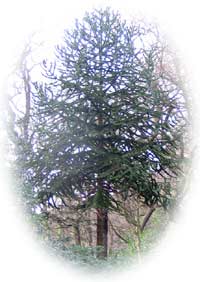 BEAUMONT
PARK, on the south-west edge of Huddersfield, West Yorkshire, is a perfect setting
for a rock (& fossil) trail because it's easily accessible. The Victorian
walkways zigzagging down through the park allow wheelchair users to reach rock
exposures (although its' going to be quite a pull getting back up again!).
BEAUMONT
PARK, on the south-west edge of Huddersfield, West Yorkshire, is a perfect setting
for a rock (& fossil) trail because it's easily accessible. The Victorian
walkways zigzagging down through the park allow wheelchair users to reach rock
exposures (although its' going to be quite a pull getting back up again!).
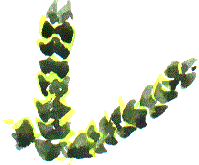 In
its Victorian heyday, the whole of the park probably boasted extensive panoramas
across the valley. Today you should take a look at the view over the Holme Valley
before you begin to descend because the trees have grown, making this a woodland
walk.
In
its Victorian heyday, the whole of the park probably boasted extensive panoramas
across the valley. Today you should take a look at the view over the Holme Valley
before you begin to descend because the trees have grown, making this a woodland
walk.
Amongst the exotic species planted in the park are two tall monkey
puzzle trees with their prehistoric-looking scaly foliage. These could
be described 'living fossils' as similar species grew at the time of the dinosaurs.
Fossil Horsetail
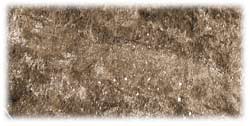
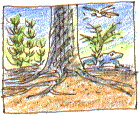 As
you reach the first exposures of rock, where boulders appear to have been incorporated
in amongst the bedrock, see if you can spot this plant fossil in one of the
rocks.
As
you reach the first exposures of rock, where boulders appear to have been incorporated
in amongst the bedrock, see if you can spot this plant fossil in one of the
rocks.
It's calamites, the giant horsetail that grew in swampy tropical
forests at a time when river channels deposited sand, which would become sandstone,
in distributary channels in a river delta, right here in Huddersfield, 300 million
years ago.
 It's
easier to see it in the actual rock but you can just make out in my photograph
(left) the parallel ribs running along the stem of calamites, just
as you'd them see in modern horsetails, such as the ones that grow as weeds
on waste ground or in marshes.
It's
easier to see it in the actual rock but you can just make out in my photograph
(left) the parallel ribs running along the stem of calamites, just
as you'd them see in modern horsetails, such as the ones that grow as weeds
on waste ground or in marshes.
Spiral Shells
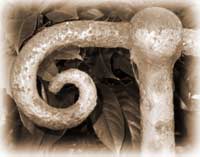 I
like the spiral details on the end of the iron handrails of the numerous flights
of stone steps leading down from the walkways. Decorative architectural details
today are so often machine made but I guess that this would have been extruded
and curved by a blacksmith.
I
like the spiral details on the end of the iron handrails of the numerous flights
of stone steps leading down from the walkways. Decorative architectural details
today are so often machine made but I guess that this would have been extruded
and curved by a blacksmith.
 Appropriately
on this rocky trail, the motif echoes the spiral logo that we use for West Yorkshire
RIGS group. West Yorkshire is famous for its fossil goniatites,
which had spiral shells.
Appropriately
on this rocky trail, the motif echoes the spiral logo that we use for West Yorkshire
RIGS group. West Yorkshire is famous for its fossil goniatites,
which had spiral shells.
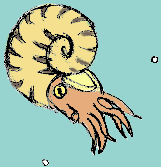
The goniatites were marine molluscs, forerunners of the ammonites and relatives
of the modern nautilus. Chambers in their shells were filled with gas so the
animal could control its buoyancy.
In an emergency, a goniatite could squirt out a jet of water to propel itself
away from danger. The problem was that it couldn't see where it was going. Giant
ammonite shells of a later period sometimes show the teeth-marks of marine reptiles
which had learnt the trick of coming up behind and below the mollusc.
Cross-bedding
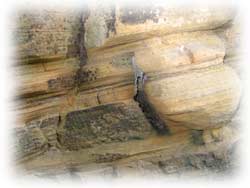
 A
feature that you see again and again in the rock-faces at Beaumont Park is cross-bedding.
What you're seeing is a cutaway view of a sand-bank. Each layer represents a
pulse of sediment deposited by the river.
A
feature that you see again and again in the rock-faces at Beaumont Park is cross-bedding.
What you're seeing is a cutaway view of a sand-bank. Each layer represents a
pulse of sediment deposited by the river.
They show up in the rock-face because, typically, coarser grains were deposited
first, then, as the current slackened, finer material followed. Weathering exploits
the differences in texture.
Slumped Sediments
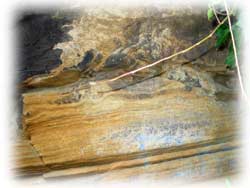
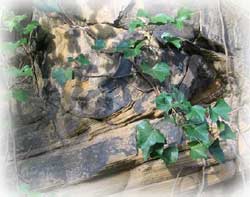 There
are some good examples of slumped sediments. At some stage
before the sand-banks we see at Beaumont Park had turned to solid rock, the
weight of subsequent loads of sand deposited on top of them by the river deformed
the regular layers. Sometimes the layers were tilted (right), sometimes
they were deformed (left).
There
are some good examples of slumped sediments. At some stage
before the sand-banks we see at Beaumont Park had turned to solid rock, the
weight of subsequent loads of sand deposited on top of them by the river deformed
the regular layers. Sometimes the layers were tilted (right), sometimes
they were deformed (left).
Wash-out
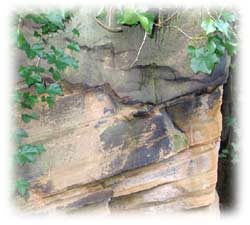 As
the river snaked about over its delta it would cut through some of the sand-banks
that it had previously deposited. You can see this in the rock-face as a wash-out,
where regular layers are abruptly cut into by another unit of sandstone.
As
the river snaked about over its delta it would cut through some of the sand-banks
that it had previously deposited. You can see this in the rock-face as a wash-out,
where regular layers are abruptly cut into by another unit of sandstone.
You're seeing a cross-section of the river channel.
‹previous
| this month | home
page | e-mail me | next›
 BEAUMONT
PARK, on the south-west edge of Huddersfield, West Yorkshire, is a perfect setting
for a rock (& fossil) trail because it's easily accessible. The Victorian
walkways zigzagging down through the park allow wheelchair users to reach rock
exposures (although its' going to be quite a pull getting back up again!).
BEAUMONT
PARK, on the south-west edge of Huddersfield, West Yorkshire, is a perfect setting
for a rock (& fossil) trail because it's easily accessible. The Victorian
walkways zigzagging down through the park allow wheelchair users to reach rock
exposures (although its' going to be quite a pull getting back up again!). In
its Victorian heyday, the whole of the park probably boasted extensive panoramas
across the valley. Today you should take a look at the view over the Holme Valley
before you begin to descend because the trees have grown, making this a woodland
walk.
In
its Victorian heyday, the whole of the park probably boasted extensive panoramas
across the valley. Today you should take a look at the view over the Holme Valley
before you begin to descend because the trees have grown, making this a woodland
walk.
 As
you reach the first exposures of rock, where boulders appear to have been incorporated
in amongst the bedrock, see if you can spot this plant fossil in one of the
rocks.
As
you reach the first exposures of rock, where boulders appear to have been incorporated
in amongst the bedrock, see if you can spot this plant fossil in one of the
rocks. It's
easier to see it in the actual rock but you can just make out in my photograph
(left) the parallel ribs running along the stem of calamites, just
as you'd them see in modern horsetails, such as the ones that grow as weeds
on waste ground or in marshes.
It's
easier to see it in the actual rock but you can just make out in my photograph
(left) the parallel ribs running along the stem of calamites, just
as you'd them see in modern horsetails, such as the ones that grow as weeds
on waste ground or in marshes. I
like the spiral details on the end of the iron handrails of the numerous flights
of stone steps leading down from the walkways. Decorative architectural details
today are so often machine made but I guess that this would have been extruded
and curved by a blacksmith.
I
like the spiral details on the end of the iron handrails of the numerous flights
of stone steps leading down from the walkways. Decorative architectural details
today are so often machine made but I guess that this would have been extruded
and curved by a blacksmith. Appropriately
on this rocky trail, the motif echoes the spiral logo that we use for West Yorkshire
RIGS group. West Yorkshire is famous for its fossil goniatites,
which had spiral shells.
Appropriately
on this rocky trail, the motif echoes the spiral logo that we use for West Yorkshire
RIGS group. West Yorkshire is famous for its fossil goniatites,
which had spiral shells.

 A
feature that you see again and again in the rock-faces at Beaumont Park is cross-bedding.
What you're seeing is a cutaway view of a sand-bank. Each layer represents a
pulse of sediment deposited by the river.
A
feature that you see again and again in the rock-faces at Beaumont Park is cross-bedding.
What you're seeing is a cutaway view of a sand-bank. Each layer represents a
pulse of sediment deposited by the river.
 There
are some good examples of slumped sediments. At some stage
before the sand-banks we see at Beaumont Park had turned to solid rock, the
weight of subsequent loads of sand deposited on top of them by the river deformed
the regular layers. Sometimes the layers were tilted (right), sometimes
they were deformed (left).
There
are some good examples of slumped sediments. At some stage
before the sand-banks we see at Beaumont Park had turned to solid rock, the
weight of subsequent loads of sand deposited on top of them by the river deformed
the regular layers. Sometimes the layers were tilted (right), sometimes
they were deformed (left). As
the river snaked about over its delta it would cut through some of the sand-banks
that it had previously deposited. You can see this in the rock-face as a wash-out,
where regular layers are abruptly cut into by another unit of sandstone.
As
the river snaked about over its delta it would cut through some of the sand-banks
that it had previously deposited. You can see this in the rock-face as a wash-out,
where regular layers are abruptly cut into by another unit of sandstone.